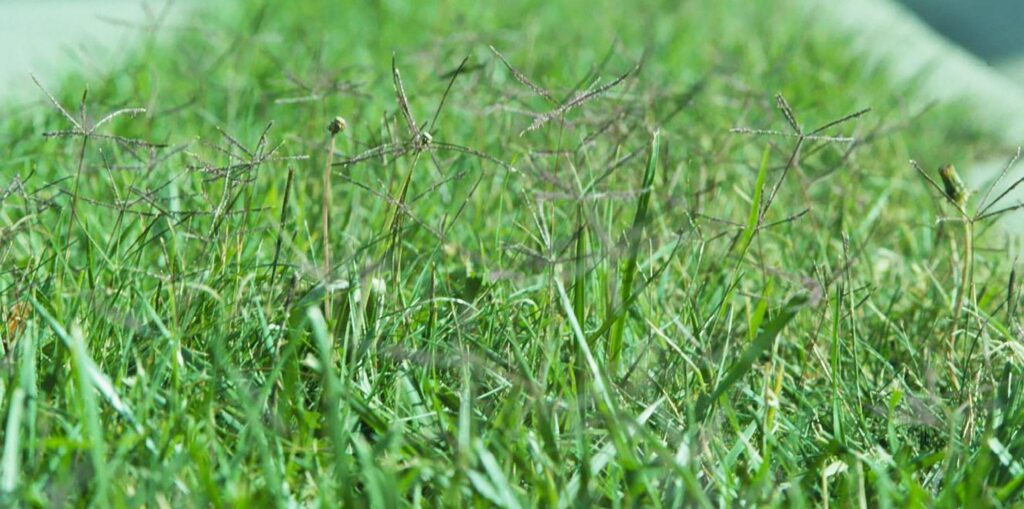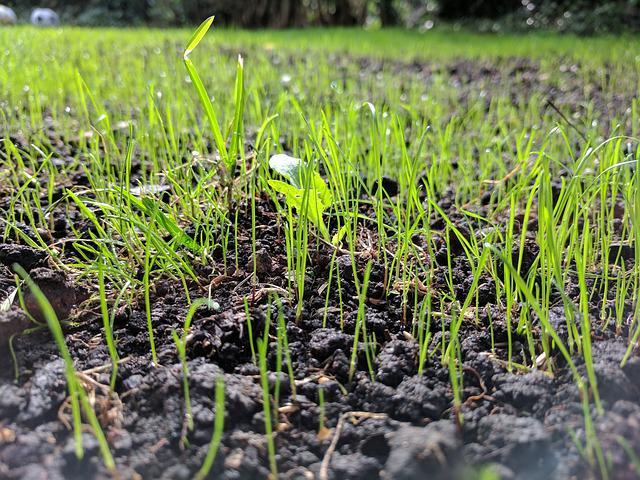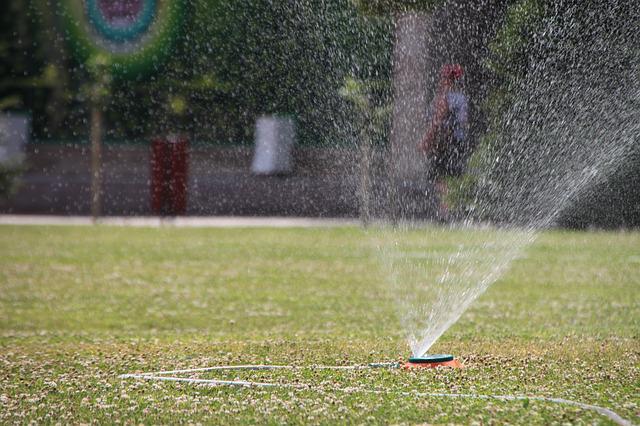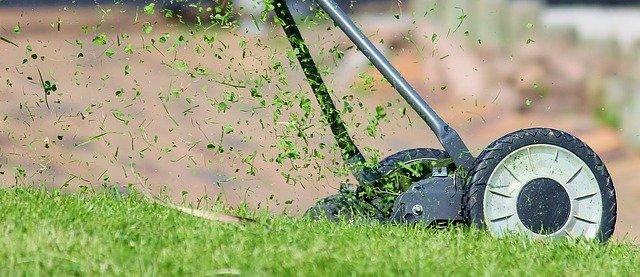Everyone loves a beautiful lush green lawn but finding a turfgrass that does not wilt in the heat or turn into dead grass when conditions become unfavorable is hard. It is especially a challenge for the people living in the South. However, there is no need to worry. Let us introduce you to the mighty Bermuda grass. It grows rapidly, and it can take scorching soil temperatures head-on. Also, the grass can grow equally well in both sandy soils and clay soils. In this article, let’s discuss about Bermuda grass watering.

Cynodon dactylon aka the Bermuda grass.
That is not all; Bermuda grass is known for its resilience too. It can withstand heavy foot traffic and repair itself quickly from the damage. So, let’s go ahead and learn about this amazing grass. In this article, we will take a look at how to plant Bermuda grass, how to water Bermuda grass, and what is the correct mowing height for Bermuda grass. We also want to mention that the main emphasis of this article will be watering Bermuda grass. Happy Reading!
How To Plant Bermuda Grass Seed

Do not plant Bermuda near winters as it has low cold tolerance.
Whenever you are seeding new grass on your lawn, it is always best to get a soil test. A soil test can tell you a lot of stuff. With the information that you obtain from a soil test, you will be able to determine what grass you should plant on your lawn. It will also help you decide the proper lawn care plant for your particular soil type. For instance, Bermuda grass can manage high soil temperatures and dry soil, but it will not grow properly in overly alkaline soil. Nonetheless, here is how to plant bermudagrass seed correctly:
- Lightly rake the soil surface. For core aeration, you can also use a power rake. It will ensure that the seeds make good contact with the soil. A good seed-to-soil contact helps the grass spread rapidly and develop a robust root system.
- Try to plant the grass during its growing season. We suggest waiting until the soil temperature is around 70 degrees or higher. This usually happens in late spring or early summer.
- For fall plantings, spread the seeds in early fall or at least 90 days before the first expected frost.
- Bermuda should only be planted in soil with good drainage and good sunlight availability.
- Initially, the seeds will need more frequent watering. At least water your lawn 3 to 4 times a day to keep the soil moist. Water ⅛ inch of water every time.
- Do not initially cover the Bermuda grass seed with mulch. However, use a weed-free mulch if necessary and only cover around 50 percent of the soil surface.
RELATED: How To Get Bermuda Grass To Spread Fast | Bermuda Grass Lawn Care Tips
Watering Bermuda Grass

Proper irrigation is necessary if you are to keep your lawn healthy.
Even though Bermuda grass is marketed as a highly drought-resistant warm-season grass, providing it with too much or too little water can still affect its growth. In addition, it can make bermudagrass lawns more prone to weeds and diseases. As a result, you will have to spend more money on weed control and disease control efforts. So, even though Bermuda grass does not need regular irrigation, you still need to provide it with adequate water to keep it actively growing and healthy.
How many times a week should I water Bermuda grass?
As already stated, despite Bermuda grass being heavily branded as desiccation-resistant grass, it is only valid when surviving without water. If you do not water Bermuda grass properly, the grass can still turn brown. This will ruin the whole purpose of establishing a home lawn as you want your grass blades to look clean, green, and serene. On average, a Bermuda lawn needs around 1 inch of water per week in most climates.
However, you might need to increase the watering amount and frequency depending on soil type and weather conditions such as heavy rainfall. For your convenience, we have described the watering requirements of Bermuda grass according to the seasons in the few paragraphs given below.
Watering Bermuda Grass In Spring
Compared to the summer months, Bermuda grass needs much less watering in the spring. However, you might have to water the newly seeded Bermuda grass more frequently. Water your lawn 3 to 4 times a day to keep the soil surface moist in the first few days. Once the grass sprouts, reduce the watering frequency to twice per day. When the new seedlings reach around 1 inch, begin watering the Bermuda grass once per day.
Once established, the Bermuda grass lawn only requires around 05 to 0.75 inches of water per week. However, you can increase the watering amount if you see signs of desiccation on your Bermuda grass lawn.
Watering Bermuda Grass In Summer
In June, July and August, a Bermuda grass lawn will need around 1 inch of water per week. It is because during the summer months, the temperature increases and the rate of water evaporation as well. As a result, not as much water gets absorbed in the soil, and thus little water is available to the grass, and it might start to turn brown.
A regular irrigation plan with proper lawn care can help you avoid such a scenario. You can install a water sprinkler system to ensure proper watering; however, it is somewhat costly and does not always justify the cost.
Watering Bermuda Grass In Fall
Fall is a time when Bermuda grass is ready to enter dormancy. If it happens, then well and good, you can reduce the watering frequency to around 1 inch per month. However, if the grass enters dormancy, you will need to water your Bermuda grass lawn accordingly. Also, keep an eye out for signs of desiccation even in dormancy, as the grass is just dormant and still needs some water or moisture to survive.
Watering Bermuda Grass In Winter
When the winter starts, Bermuda grass has already entered dormancy. In areas with adequate rainfall, sometimes you might not even need to water the Bermuda grass throughout the entire winter months. However, in areas with dry winters or very little rain, it is necessary to water the Bermuda grass to prevent winter desiccation. As already stated, even the completely dormant Bermuda grass needs some amount of moisture to survive.
RELATED: St. Augustine Grass Vs. Bermuda Grass: What’s The Difference And Which Is Better?
How often should I water Bermuda grass?
Depending on the soil type, temperature, and the area’s weather conditions, you will have to change the watering amount and frequency between different seasons. We suggest watering your Bermuda grass lawn infrequently and deeply. Such a watering schedule will help the grass roots grow deep, increasing the resilience of your turf.
Watering shallow and very frequently can introduce a number of weed and insect problems to your lawn. It can also make your lawn more prone to fungal diseases such as brown patch disease, dollar spot disease, and spring dead spot disease.
Here is a table that quickly summarizes the watering requirements of Bermuda grass across different seasons and how often you should water your Bermuda grass lawn.
| Season | Water requirements |
| Spring | 0.5 to 0.75 inches of water per week |
| Summer | 1 to 1.25 inches of water per week |
| Fall | Around one inch of water per month |
| Winter | One inch of water in a month (In high rainfall areas, it is not needed) |
What is the best time to water Bermuda grass?
Anywhere near early morning is a perfect time to water Bermuda grass. It will ensure that the soil and the grass blades dry before the sunset. Also, the chances of excess water standing on your lawn will be much reduced if you water your lawn early in the morning. The sunlight throughout the day will ensure that any excess moisture evaporates from the soil surface and does not become a home to water bugs and moisture-loving fungus.
Is it bad to water grass at night?
If you water Bermuda grass at night, the chances of excess moisture staying on the ground will increase. This will make your lawn extremely prone to lawn diseases and fungal attacks.
RELATED: How to Plant Bermuda Grass | Bermuda Grass Growth Stages and Care
Can you overwater Bermuda grass?

Overwatering can increase soil compaction issues in your yard.
It is not a good idea to overwater Bermuda grass. It can interfere with root development, soil chemistry, and the overall growth of the grass. Overwatering clogs the soil and makes the grass more prone to fungal diseases and pest attacks. In addition to that, if you water Bermuda grass too much, it can create all sorts of soil compaction problems. Soil compaction will reduce the resilience of grass, reducing its ability to recover from stress or heavy foot traffic.
A compacted soil will also stop the water and air from penetrating the deeper soil layers which will, in turn, affect the growth of grass. Again, it is because the standing water over the compacted soil blocks oxygen from reaching the roots. As a result, grass plants suffocate and ultimately die. Also, as already stated, overwatering can increase the moisture content of the soil.
A humid environment is the best breeding place for lawn fungus and many microbes and pests, which could negatively affect your Bermuda grass. The fungi can quickly take over a lawn as they grow explosively in moist conditions. A fungal infection will definitely make fungicide treatment necessary which will just add to the cost of lawn care.
How do you fix overwatered Bermuda grass?
Fixing an overwater Bermuda grass lawn includes thatch removal and aeration of the yard. Aeration takes care of the compacted soil and opens up the soil for better air and water penetration. Whereas dethatching also has somewhat similar effects while also making your lawn look cleaner and greener.
Should you water dormant Bermuda grass?
Since Bermuda is a warm-season grass, it enters dormancy during the winter. As a result, it turns brown, but it does not mean that you do not need to water Bermuda grass now. The grass still requires some moisture to keep hydrated and to survive.
However, the watering frequency for dormant Bermuda grass is much lower than the watering requirements of the growing season. In general, dormant Bermuda grass needs only around half an inch of water every two to three weeks.
How long should I water Bermuda grass?
Bermuda grass has only moderate watering requirements. In order to determine how long you should water the Bermuda grass lawn, here is a simple trick.
- Turn on the water sprinkler on the lawn and place five small cups randomly on your lawn.
- Leave the sprinkler on for about an hour.
- After an hour, measure the depth of water collected in each cup.
- Calculate the average water depth by adding all the depths and dividing them by five.
- Now divide one inch by the above-obtained number, and the answer will tell you how long you should water the Bermuda grass lawn.
For example, suppose only 0.5 inches of water was collected in the cups on average. In that case, you will need to water your Bermuda grass lawn for around 2 hours to get to 1 inch of water. Obviously, with different seasons and weather conditions, you will have to adjust the watering time accordingly.
Mowing Bermuda Grass

Always use a sharp mower blade while mowing the lawn.
Proper mowing is just as crucial for the health of your Bermuda grass lawn as adequate watering. It keeps your lawn grass clean and short and prevents weeds and other invaders from taking hold of your yard. Also, it removes the weak grass blades and only allows the best and healthiest grass blades to grow further, increasing the lawn’s resilience in the long run. Here is how you can mow your lawn correctly:
- Use a lawn mower with a sharp mower blade. It will ensure that your lawn gets mowed equally and uniformly, which adds to the beauty of the lawn.
- Depending on your needs, you can choose between a reel mower or a rotary mower. A rotary mower is usually used for high mowing heights. In contrast, a reel mower is best suited for lower mowing heights.
- Set the reel mower mowing height to around 1 or 2 inches. Setting mowing heights higher than this means that you will need more frequent mowing sessions in the long run.
- If there is too much thatch on the lawn, you can use a vertical mower with a sharp mower blade to do the job.
- Another important thing to note is that hybrid Bermuda grass varieties are usually mowed at a height of 0.5 to 0.75 inches.
- Begin mowing your grass when it reaches a height of around four inches. Also, do not cut more than one-third of a grass blade in a single mowing session.
- If the grass is healthy and does not have any fungal or pest infection, we suggest leaving the grass clippings behind after mowing the lawn.
- The grass clippings decompose rapidly and can be an excellent compost for your Bermuda grass lawn, especially during the growing season.
Bermuda Grass Weed Control
No matter how strict management practices you put in place, sooner or later, weeds will appear on your lawn. It is often the broadleaf weeds that show up in a Bermuda turf and may force you to use Broadleaf weed herbicides from time to time. Crabgrass is a common weed on Bermuda grass lawns, and if you do not control crabgrass on time, it can ruin the aesthetics of your entire Bermuda grass lawn.
However, we do not suggest that you heavily use herbicides on your lawn. In fact, we recommend that you only apply herbicides to the affected areas of your turf. However, in areas where Bermuda grass lawns are prone to weed infestations, you might need to use pre-emergent and post-emergent herbicides to maintain healthy turf regularly.
In any case, consult a lawn care specialist before you apply any chemical herbicides to the grass.
We hope you learned something from this article, here are other articles that you can learn from:
Sources for Further Reading
- Bermudagrass Yearly Maintenance Program. (2022). Retrieved 27 April 2022, from https://hgic.clemson.edu/factsheet/bermudagrass-maintenance-calendar/
- Bermudagrass. (2022). K-state Research Extension. Retrieved 27 April 2022, from https://www.ford.k-state.edu/lawn-garden/bermudagrass.html
- Turfgrass Irrigation | New Mexico State University – BE BOLD. Shape the Future. (2022). Retrieved 27 April 2022, from https://pubs.nmsu.edu/_circulars/CR660/
We hope you learned something from this article, here are other articles that you can learn from:
Buffalo Grass 101: Is It Any Good & How Can You Grow It In Your Yard?
Should You Spray Weeds Before Or After Rain? Best Time To Spray
Zoysia Grass – Popular Types | How To Choose The Right Zoysia For Your Lawn







